Mie goreng, or mee goreng and sometimes called bami goreng, is an Indonesian fried noodle dish made with yellow/wheat noodles and tastes sweet and savory with a mild kick. It's easy to make, takes less than 30 minutes, and is incredibly delicious and addictive! But if you prefer rice noodle, try our bihun goreng instead.

Mie goreng is one of the most popular comfort food and street food of Indonesia and Southeast Asia. It's a stir fried noodle dish seasoned mainly with kecap manis (sweet soy sauce) and some chili sauce or sambal, which makes it sweet and savory with a little kick. So flavorful. So addictive!
Jump to:

Ingredient notes
Please scroll down to the recipe card for the ingredient quantities!
For the fried noodle dish:
- Noodles - Fresh egg noodles, like chow mein noodles and thin lo mein noodles, are great options for mie goreng. Their texture hold up well to heat and is pretty forgiving. Instant ramen noodles are also a great choice for making mie goreng.
- Protein - Feel free to use any proteins of your choice or omit the protein if you prefer. You could use only one protein or a combination. We usually like to add slices of chicken and shrimps.
- Choy sum - This is the most classic greens used in mie goreng. Choy sum literally translates to "heart of vegetable" and can be found at most Asian markets. However, if you cannot find choy sum, your favorite leafy green vegetables will work perfectly as substitutes.
- Shallot and garlic - These two are the main aromatics for mie goreng. Both will add tons of flavor to the oil that will be used to pan fry the noodles.
- Eggs (optional) - Fried eggs are commonly served with mie goreng. Feel free to use or omit.
- Oil - Any neutral cooking oil is fine.

For the sauces and seasonings:
- Kecap manis - Also known as sweet soy sauce. It's a little bit syrupy in consistency. We've tested out both generic sweet soy sauce and Indonesian kecap manis, and the results were pretty similar. So feel free to get which ever you can find. DON'T confuse them with thick or thin soy sauce!
- Chili sauce - We recommend finding Indonesian or Malaysian chili sauce. It is thicker, and tastes sweet and has a bit of a kick. It is not the same as sweet chili sauce. We used Dua Belibis chili sauce. You can find it at most Asian markets.
- Chicken bouillon powder - The concentration of umami, chicken flavors from chicken bouillon powder gives homemade mie goreng the boost it needs.
- Onion powder - Although fresh garlic and shallots is very aromatic, onion powder enhances that aromatic flavor even more. We highly recommend not skipping.
- Salt and white pepper - Just a little salt to round out the needed saltiness and savory flavor and the white pepper adds depth.

Best noodles for making mie goreng
Mie goreng from street vendors in Southeast Asia often use instant ramen noodles. These noodles are relatively cheaper, more accessible, and are fried, which makes them taste amazing!
But to make our homemade version a bit healthier, we opted for fresh egg noodles instead. We find that fresh egg noodles tend to be more forgiving in terms of cook time, and they keep their slightly chewy texture well, even if the noodles are cooked a little longer than recommended.
So, it's really up to your preference. Both egg noodles, like the fresh chow mein noodles we used, and instant ramen noodles are great choices.

How to make mie goreng
Please scroll down to the recipe card for the full recipe and instructions!
Prepare the ingredients:
1. Prepare the protein. Proteins such as chicken, pork, and beef can be thinly sliced and lightly seasoned with salt. Shrimps should be peeled and deveined and seasoned with salt.


2. Blanch the noodles. Add the noodles to a pot of boiling water. Cook the noodles until just al-dente and drain immediately.

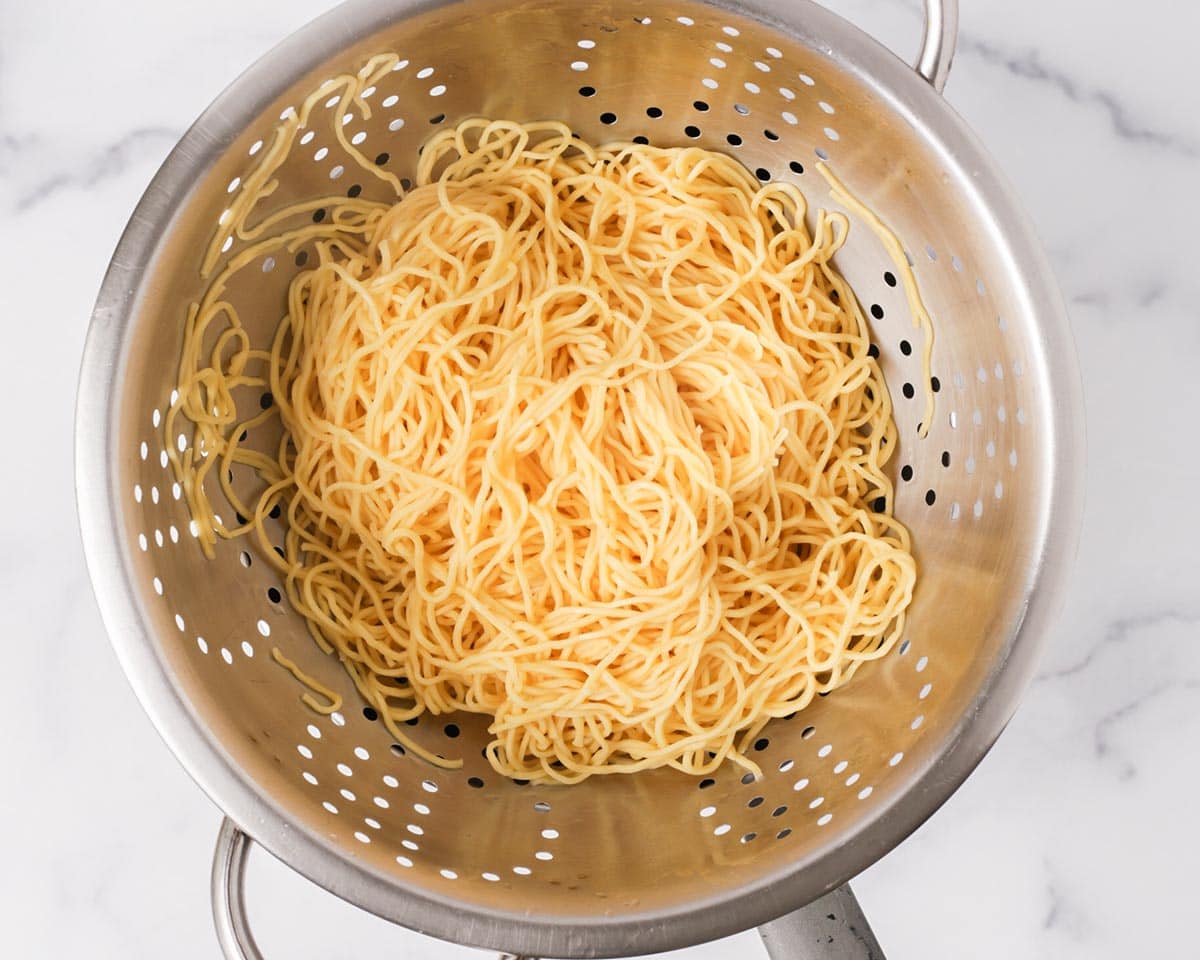
🌟 Pro tip: After draining the noodles, fluff the noodles to help the steam release. This will help dry out the noodles, which means the noodles won't have to be stir fried for as long. It will also help prevent the noodles from clumping as much.
3. Smash the aromatics. Use a mortar and pestle to smash the shallot and garlic into a paste. This is optional to help the aromatics release more flavor, which will make the fried noodles more flavorful. If you prefer, you could just finely minced the aromatics instead.


4. Cook the protein. In a nonstick pan or well seasoned wok over medium high heat, generously grease the bottom of the pan. Once the pan is hot, add the protein and stir fry until just cooked. Remove the protein and set aside.


🌟 Pro tip: There will be lots of brown fond on the bottom of the pan/wok after cooking the protein. You can either wash the pan, use a new pan, or make sure to scrape the pan well while sautéing the aromatics in the next step. The fond adds lots of flavor but may also encourage burning if the heat is not well controlled.
Make the mie goreng:
5. Saute the aromatics. In the same pan or wok, reduce the heat to medium and add about 4 tablespoons of oil. Once the oil is hot, add the shallot and garlic paste. Saute until the aromatics are fragrant and starting to brown.

6. Pan fry the noodles. Into same pan with the aromatics, toss and stir fry the blanched noodles for a few minutes to help remove any leftover moisture.

7. Sauté the choy sum. Add the stems of the choy sum and sauté for a minute. Following, add the leaves of the choy sum and cook for another minute until they are start to wilt.

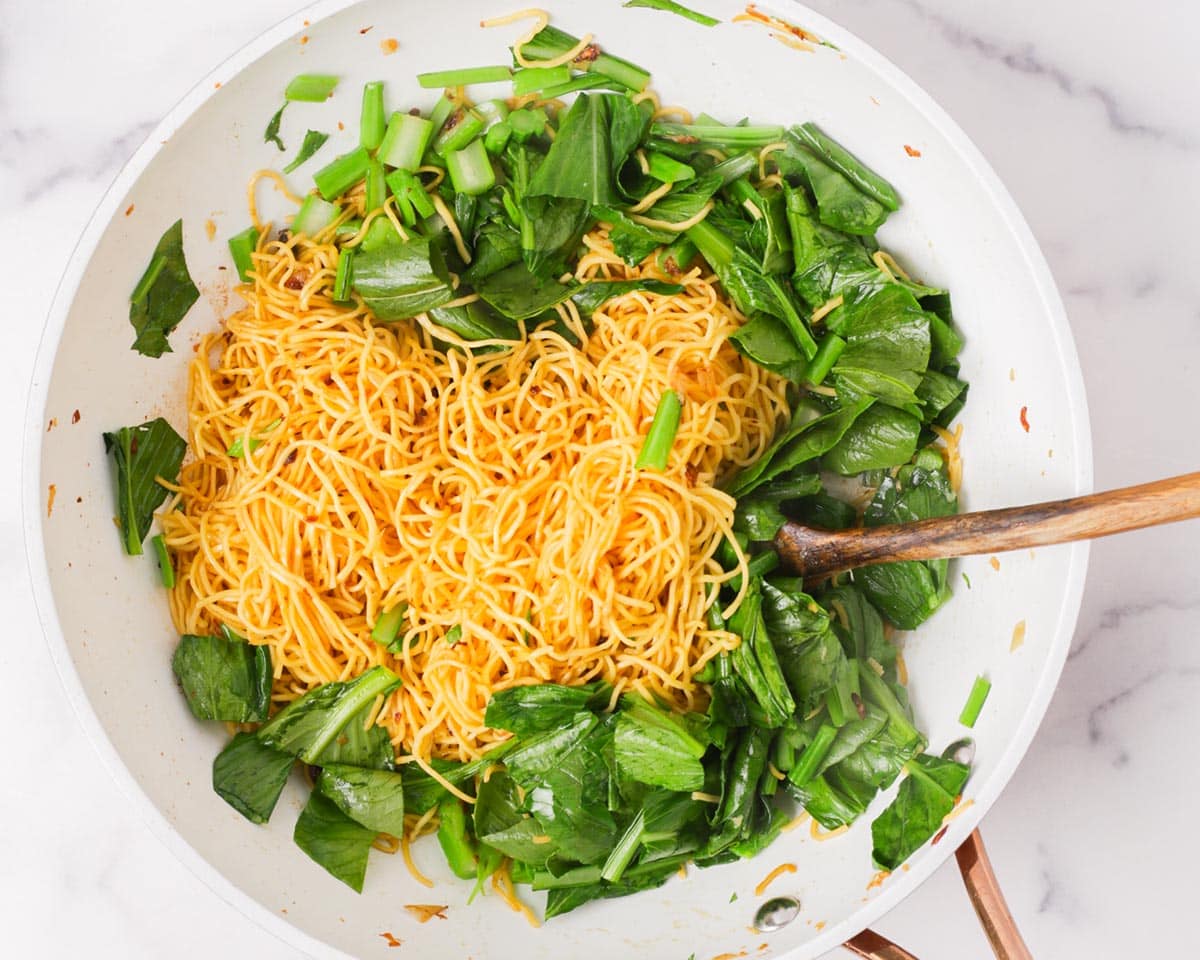
8. Season. Add the kecap manis, chili sauce, chicken bouillon powder, onion powder, salt, and white pepper. Also add the cooked protein. Sauté and toss everything together until well combined and evenly coated with the sauces and seasonings. Enjoy while hot!


9. Optional: Fry egg. In a frying pan or wok over medium high heat, add a generous amount of oil to cover the bottom. Once the oil starts to smoke and shimmer, crack the eggs into the pan and fry until the eggs are your desired doneness and the bottom of the eggs are golden brown and wispy. Remove and enjoy with mie goreng.

Recipe tips
- Blanch the noodles to no more than al-dente because the noodles need to be pan fried after blanching. So we recommend undercooking the noodles so that they do not become overcooked when stir frying.
- Fluff the noodles after draining to help release as much steam as possible. This way the noodles can dry faster and less time will be needed for pan frying. Fluffing the noodles will also help the noodles from clumping as much, which will make stir frying easier.
- Stir fry the heartier parts of the vegetable first. This applies even if the choy sum is substituted with vegetables of your choice. It will prevent the softer parts of the vegetables from becoming overcooked.
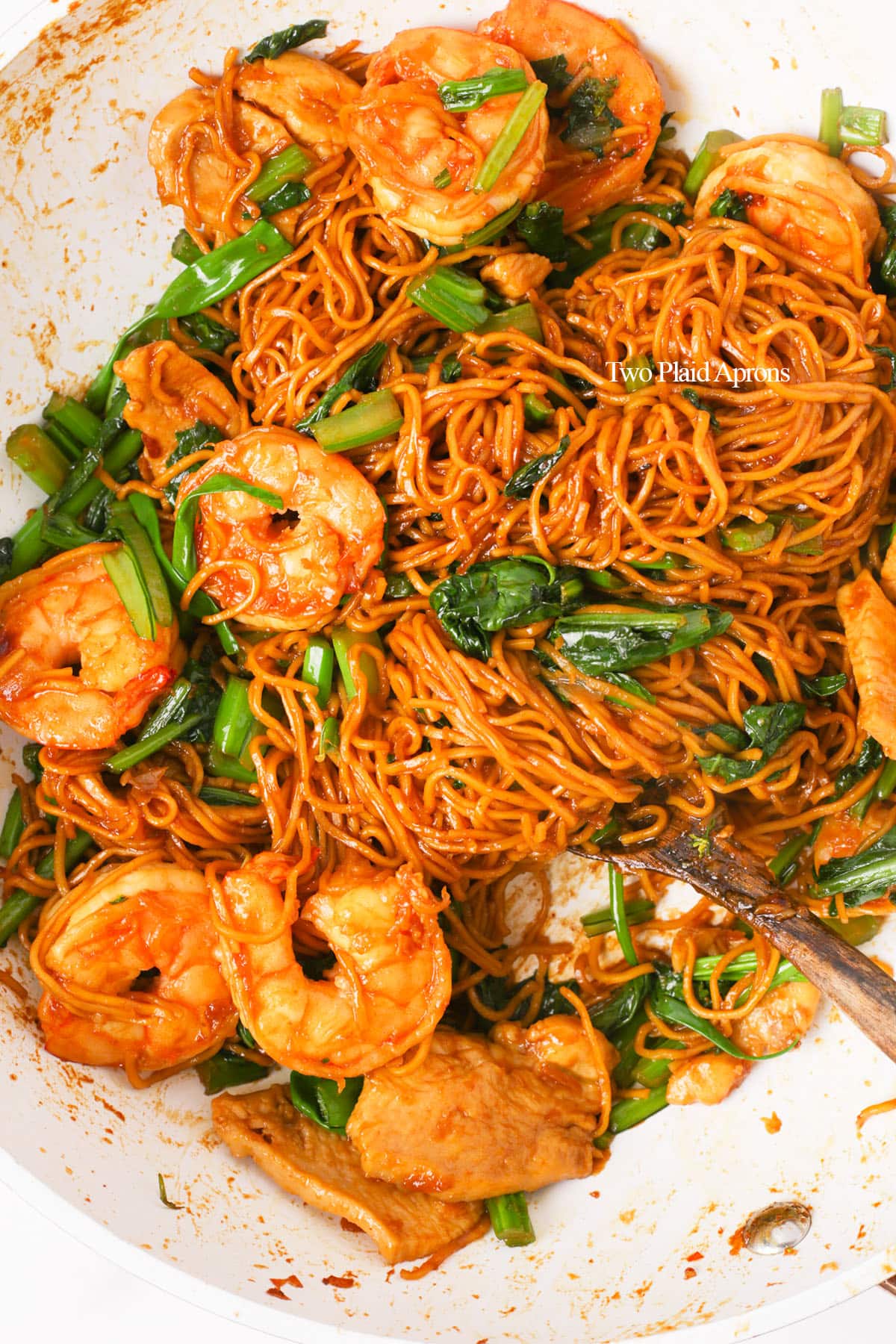
Storage and reheating
Leftover mie goreng can be stored in the fridge for up to 3 to 4 days. Make sure to allow the leftover to cool completely before covering.
To reheat, stir fry the leftover mie goreng in a nonstick pan over medium heat. Add a small amount of water to the noodles and cover with a lid to "steam" the noodles and help it warm up faster. Then, stir fry for a couple of minutes to dry out any leftover moisture.
If you prefer, you could also simply cover the leftover and microwave it until heated through. Just make sure to use a microwave safe container.

FAQ
They are the same thing. Mie and bami both translates to "noodles" while goreng translates to "fried". So both mie goreng and bami goreng refers to fried noodles.
Mie goreng is a sweet and savory Indonesian fried noodle dish, while nasi goreng is Indonesian fried rice.
Fresh egg noodles (like chow mein and thin low mein) are the best noodles to use for making mie goreng because they are very forgiving and maintains their slightly chewy texture well. Instant ramen noodles are also a great choice.
If you’ve made this recipe or any recipes from our blog, please tag us on Instagram using #twoplaidaprons! You can also tag us in your Instagram stories using @two_plaid_aprons. We would love to see your creations! It absolutely makes our day! 🥰
📖 Recipe
Mie Goreng (Indonesian Fried Noodles)
Ingredients
For the dish:
- 6 ounces fresh egg noodles (like chow mein or lo mein noodles) *see notes
- 12 ounces protein of your choice (shrimp, chicken, pork, beef, or a combination)
- 8 ounces choy sum cleaned and cut into 1 inch pieces
- 2 stalks green onion just the green part; cut into 1 inch pieces (optional)
- 2 large eggs (optional)
- 1 medium shallot peeled and cut into smaller chunks
- 3 cloves garlic peeled and cut into smaller chunks
- 4 tablespoons oil or as needed for cooking (any neutral cooking oil)
Sauces and seasonings:
- 3 tablespoons kecap manis sweet soy sauce
- 1 tablespoons chili sauce
- 1 teaspoon chicken bouillon powder
- ½ teaspoon onion powder
- ¼ teaspoon salt or season to taste
- Pinch of white pepper (optional)
Instructions
- Prepare the protein:If using chicken, beef, or pork, cut the protein into thin slices. Lightly season the protein with some salt, and mix to combine.If using shrimp, peel and devein. Then, season lightly with salt. Mix to combine.Set the protein aside until needed.
- Prepare the noodles:Bring a pot of water to a boil and add the noodles. Cook the noodles to al-dente. Drain well and fluff with chopsticks or tongs to help release steam. Set aside until needed.*Be careful! The noodles will be very hot!*
- Prepare the aromatics:Use a mortar and pestle to smash the shallot and garlic into a paste. Set aside until needed.*If you prefer, you could finely mince both the shallot and garlic. However, the flavors of the mashed aromatics will be better.*
- Cook the protein:In a nonstick pan or well seasoned wok over medium high heat, add enough oil to grease the bottom. Once the oil is hot, add the seasoned protein and sear on both sides until just cooked. Don't overcrowd the pan. Cook in small batches if necessary. Once done, remove the protein and set aside.
- Stir fry the dish:Into the same pan or wok over medium heat, add about 4 tablespoons of oil. When the oil is hot, add the shallot and garlic paste and saute until fragrant and the aromatics are starting to brown. *Make sure to scrape the bottom of the pan to help release the fond. You could also wash the pan or use a new pan if you prefer.*
- To the aromatics, add the noodles and stir fry for a couple of minutes, tossing occasionally, to dry out the noodles.
- Add the choy sum stems to the pan and stir fry for about 1 minute. Following, add the choy sum leaves and stir frying everything for another minute.
- Reduce the heat to medium low and add all the sauces and seasonings (kecap manis, chili sauce, chicken bouillon powder, onion powder, salt, and white pepper). Also return the cooked protein to the pan and add the green onions. Toss and stir fry everything until evenly coated with the sauces and seasonings.
- Serve with fried egg if you'd like. Enjoy while hot!
- Optional - Fry egg:In a frying pan over medium high heat, generously coat the bottom of the pan with cooking oil. Once the oil is hot and shimmering, crack the eggs into the oil and fry until desired doneness. Remove from pan and serve with mie goreng.
Notes
- Fresh egg noodles - Feel free to use any egg noodles of your choice. You can also use instant ramen noodles, if you'd like. Please refer to the post for more details.
- Protein - Mie goreng can be served with or without protein. So feel free to omit the protein completely if you prefer. Also, feel free to use only one protein or a combination of proteins. We recommend that proteins like chicken, beef, and pork to be cut into thin slices for faster cooking. Shrimps can be simply peeled and deveined.
- Choy sum - This is a common Chinese/Asian green sold at most Asian markets. However, if you can't find it, simply substitute it for your favorite vegetables like broccoli, kale, and cabbage.











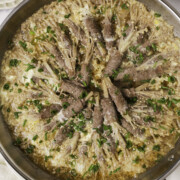









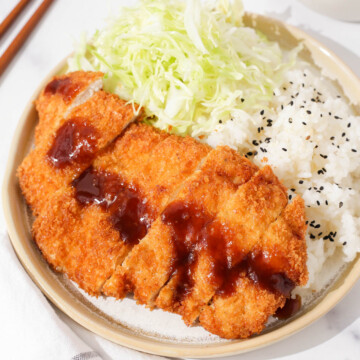
Comments
No Comments